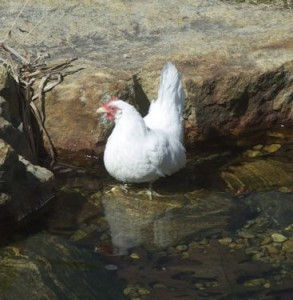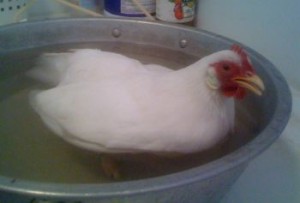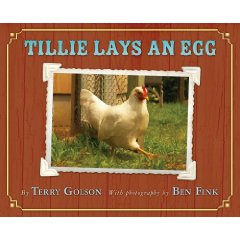Yesterday, Eggers was looking so perky and well that I let her back in with the other hens for the afternoon. In the evening, I closed her up in a dog crate so that she would drink her medicated water. This morning, she was dead.
I recently attended a chicken necropsy workshop; this was the right situation to use that information. Egger’s daughter, whom I gave to a friend, also died under similar circumstances. First the hen looks uncomfortable and lethargic. Then, she responds to antibiotics, and then she is dead. I wanted to know what was going on. Unfortunately, my first attempt at a necropsy didn’t show up anything obvious.
To my inexperienced eye, all of the internal organs looked fine. Although there were no eggs making their way down the oviduct, the ovaries looked normal with tiny pearl-like eggs. The intestinal tract was unobstructed, and the liver, heart and lungs were the right sizes and clear of blemishes. I made use of one of the most useful, clearly illustrated books in my library, The Prairie Farmer’s Poultry Book, from 1925, which has line drawings of chicken anatomy and photos of diseased birds. Another helpful book is Poultry Sanitation and Disease from 1939.
Perhaps Eggers had an unseen genetic heart abnormality? I’ve no idea. Eggers was only three years old. Alma, a Wyandotte, also died at three of no apparent reason. Ginger, my beautiful sex-link hen, was three when she died, again of no known illness, and without any warning symptoms. Perhaps this is age-related? I’ve heard from other chicken keepers who say that their high-producing hens give out early. There’s so little known about older hens. After all, hens aren’t bred for longevity; breeders focus on desired traits like egg production or feather color. I’d like to see us backyard chicken keepers keeping accurate records and then sharing them. I think that much could be learned.







